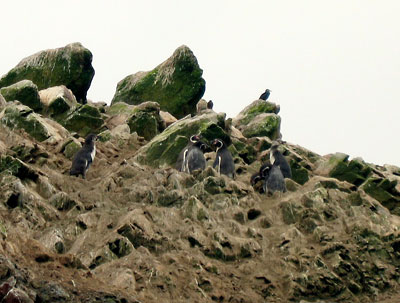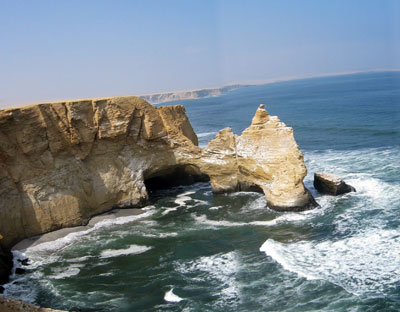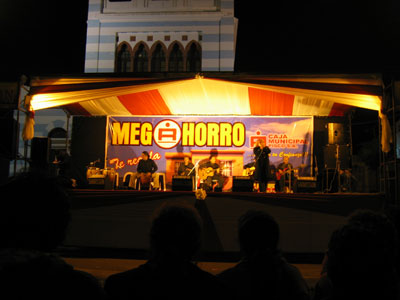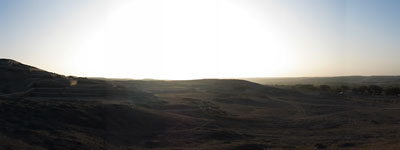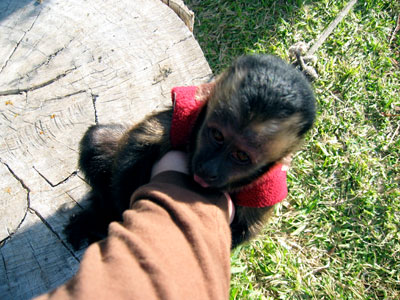Last weekend the students and I were led on a tour of southern Peru by Lin, who works… wow we just had a small earthquake*. Anyway, he works at the same museum the bioarchaeology students and I work at and he’s helped us to adjust a great deal. While the archaeoastronomy students and I were hanging out with him and some other Peruvian students, he invited us to go with him to see some of the southern towns. Apparently he has a brother who has connections there. The following weekend (one week ago) we hopped on a tour bus. Destination: Pisco.
Pisco is a town which shares its name with the brandy it produces. We arrived late a night. The town looks like a bomb went off, with piles of construction rubble and broken sidewalks scattered about. We quickly got settled in the hotel “The Eden” for the night. Far from being a paradise, it was creepy and smelly. It didn’t matter too much to us (though the yellow stain on the wall adjacent to my bed was worrisome) and we slept in preparation for the next day.
The next morning we were roused awake when the tour bus arrived a half hour earlier than what we were told. Lin was not there yet (we think he stayed with a friend) so we were very confused. Eventually we got on the bus and headed towards the town of Paracas to see the Islas Ballestas.
The Islas Ballestas are a chain of islands compared to the Galapagos islands. In the 1800s it was important because guano miners could excavate some bird poo for sale to other countries as fertilizer. There are meters of bird poo that still cover the islands since it’s a renewable resource. If I remember right, 80% of the Peru GNP was guano during that time. Unfortunately, the goldmine of poo was sought after by Chile, which in part lead to wars between the two countries, which Peru pretty much lost.
To see these islands, we take speedboats. The dock had swarms of pelicans milling about waiting for a kid holding a raw fish to toss it in the air for them to fight over. One one side, several men were trying to tow a car towing a boat that had somehow sank into the water. The lead car tried to pull them both out, but the cable connecting them snapped and the stuck car got stuck even more. I didn’t want to take pictures of someone’s bad day so I kept going to the boat. The dock also had some interesting signs:
With a mish-mash of tourists from all over Europe we jetted off for the islands. The tour was awesome: there were pelicans, sea lions, cool rock formations, and yes, bioarch students: we saw that penguins do indeed live in Peru:
After the boat tour we got in a cab to see Paracas proper. Unlike the tiny modern town, the Reserva Natural de Paracas is a gigantic wildlife and archaeology reserve. It covers a section of the coastal desert, and part of the ocean as well. We saw the little but well-made museum which had some examples of Paracas textiles and the famous funerary bundles of cotton and other offerings. After the museum, we saw some of the natural formations on the coast, such as the Catedral:
From the reserve we were driven to Tambo Colorado, an Inca outpost a few kilometers inland. It is one of the top five examples of Inca design in Peru. We had the site all to ourselves so Lin showed us the maze of corridors and rooms. He grew up in the area and spent some of his childhood exploring the site before it became a protected tourist attraction. Tambo Colorado (Tambo means an Inca outpost and Colorado means colored, because some red paint still exists on some of the walls) was a local ceremonial center, storehouse, and elite getaway for the Sapa Inca, the Inca leader. The site now shows the mark of five hundred years of history: in some of the Inca niches visitors in the 19th century had carved poems in cursive into the plaster wall.
After Tambo Colorado we went back to Pisco to eat and rest. There was nothing planned that night, but we were awoken from our naps by a blast of live music. We thought it must have been really close, but we looked out the window and saw that it was coming from a stage all the way across the plaza:
The Lonely Planet guide says this town is dangerous at night so we were a bit reluctant to leave “The Eden.” Being a bit daring (“I’m unrobbable!”) I went off by myself to check out the concert scene. Pisco was very lively. People were watching the concert, kids ran around the plaza, and I saw a very busy pedestrian street. I found that it was lined by restaurants, bars, and strangely, giant electronic store chains shrunken to Pisco size. I walked around taking it all in before returning to the hotel to report that Pisco at night was indeed safe. We went out to dinner and most of us pooped out after that. Patrick went out with Lin to a baby shower and then dancing. The plaza concert lasted until 2AM or so, keeping us awake.
There was no time for rest as we were off again the next morning at 6AM. This time we were getting on a bus first to the town of Ica, capital of the Ica department, and then off to Nasca. Lin offered to take us there so we could fly over the Nasca lines and being archaeology dorks, we all leapt at the chance. Nasca was scorching and we felt even more tired. We learned that early morning clouds had delayed the flights, and the earliest we could possibly get into the air was 3PM. We had lunch and Lin took us around. We went to some ceramic and metallurgy workshops to see how they do their crafts. When our flight was delayed to the next morning, we went 25km away to Cahuachi, a Nasca site. There was an archaeological field school going on at the time. One of the Peruvian archaeology students showed us around. We couldn’t get too close but I did take a 360° panorama:
We had dinner at a chicken restaurant near our Nasca hotel. I rested a bit while Lin was away doing Lin things and the students went to a planetarium to see their presentation. We walked around Nasca at night, which was a lot more charming and temperate than in the afternoon, and spent the night in town.
The next morning we went to the Nasca Aerodome where the small planes for tours over the lines are located. After a little bit of waiting they asked for three of us to volunteer to go. I didn’t want to turn this decision into a drawn out thing so I kind of ordered the three students to go. They gladly went while I waited on the ground and took pictures.
They came back after a half hour or so and it was my turn, sharing a plane with a young Italian couple. I sat in the front seat next to the pilot. I’ve always been wary of small planes but the flight was very enjoyable. We did some hard banking over the lines for our photography needs but I didn’t feel a thing. I heard that two of the students had a puke fest on the first flight.
To be honest the line formations that made pictures of animals and things looked really small from so high above. I don’t believe for a minute that you cannot appreciate them from the ground, especially if you know what is there beforehand. They’re also far from perfectly shaped. If I had 500 people holding hands I could have them spread out and form a large shape in the sand. Once they are in place I’d have them remove the soil around their feet, join these clearings with their neighbors’ and we’d have a picture of whatever I wanted of comparable quality. No aliens needed.
After I landed we were off again on our next adventure: sandboarding! Near the town of Ica is a small oasis resort called Huacachina. There we hopped on a dune buggy and were taken on a bumpy tour of the local sand dunes. How bumpy was it? Well see for yourself:
The dune buggy stopped on top of a fair-sized dune. The driver, Luis, hopped out and pulled some sandboards out of the back. They looked pretty much like snowboards. He showed us how to lay on them surfer style and launch ourselves down the sand dune. It was awesome! The sheer sense of speed is something that will stay with me for a long time. He picked us up again at the bottom of the dune and drove us to a bigger one. By the fourth set of dunes we were looking down hundreds of yards of sand. We all had a lot of fun. Since I weighed more than the others I went the farthest (Force equals mass times acceleration). So in a way, I got more out of it, lol.
After our pockets and shoes were well-filled with sand, Luis drove us back to the resort. We got some much needed cold drinks and ice cream. At the inn we were based at, there was an odd menagerie of animals milling about. There were peacocks, dogs, a turtle, and a monkey of all things. The monkey was very nice and cute. Maybe, too nice. I found that, unlike a cat which I could brush off of me, the monkey would not be put down. It’s little prehensile hands and and feet would grab anything on me: my shirt, my lip (!), my camera, etc. It preferred holding on to me rather than the tree it was leashed to or the grass. It was also extremely bitey, chewing the heck out of my fingers, arm, and camera just for kicks.
A British guy helped me out by taking the monkey from me, but then it was stuck to him. We laughed that it’s like a cold: we can only get rid of it by passing it to someone else (Ok, not really, but it’s a folk belief). Eventually we got away when it hopped on the ground to transfer itself between us and we both darted out of the range of his leash. The other guy must have felt sorry for it because when I came back out from a cafe, the monkey was back on his shoulder.
We left Huacachina and went back to the bus station in Ica. There we got on a bus back to Lima, a four and a half hour trip. We were exhausted and I passed out as soon as I hit my bed at the Villa Rica. It was amazing that I made it to work on time the next day. Well, Ok I was 15 minutes late.
Thanks for reading through all this. We had a busy weekend! It’s been a week and I’m still tired from the trip and bruised from the dune buggy.
*Today is Fiestas Patrias, Peru’s independence day. The fact that an earthquake occurred during a Catholic mass at the main cathedral with the president in the audience is not a good omen!

